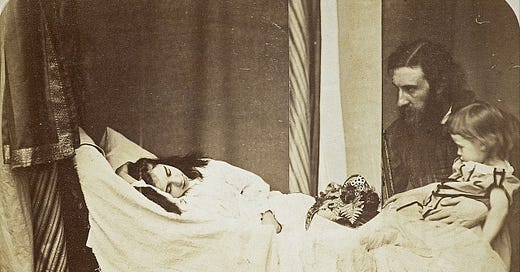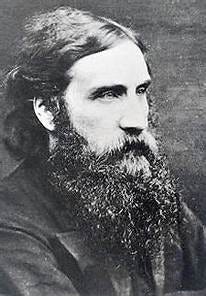Theological Immunities
Long ago, in the 1800s, there was a Scottish writer by the name of George MacDonald. Largely forgotten today, he’s one of those figures who, though you’ve probably never heard of him, nonetheless casts a long shadow. For one, he was the mentor of Lewis Carroll and, without him, The Adventures of Alice in Wonderland might never have been written. For two, his work can be reliably cited as one of the primary reasons for the conversion of a certain C.S. Lewis.
Now, modern Christianity has mostly forgotten MacDonald. This is a great detriment. Largely, I suspect that we have forgotten him mostly because his works of fiction simply aren’t all that good. They’re alright, sure, but modern readers have come to expect more from their fantasy. He was a pioneer for his time, certainly, but his novels haven’t aged all that well. Unfortunately then, because his lineage is so wrapped up in the work of other literary giants, like Carrol and Lewis and Lord Byron, he’s naturally been judged (and dismissed) on the basis of his skill as an author, but honestly this is the exact wrong way to see him. For MacDonald you see, first and foremost, was a pastor. It is in his sermons, not his fantasy, that his true genius shines.
Now I know. I know. Reading sermons. Right? How dreadful. How boring. And, worse, reading sermons from the 1800s. Ugh. Why not rather just throw soot on our faces and climb down a cholera filled chimney? The entire period is known for being dreary and depressing, an era full of Tiny Tims half starving to death in the cold. Reading a sermon… from then?
I understand.
Trust me when I say though that MacDonald The Preacher was as far away from a Dickens or a Melville as you could get. Indeed, instead of being dull and dreary, his sermons are filled with a kind of light frivolity. The man possessed the spirituality of a poet, or perhaps even that of a Celtic bard and, while it’s clear that he had a deep familiarity and understanding of the theological tradition from Paul to Aquinas to Calvin… he comes off nowhere near so stuffy. As Lewis put it (paraphrasing), “I know of no man who comes nearer to the heart of Christ.”
Well said.
I think Lewis was right.
In my own life, during my own dark nights of the soul, again and again I have returned to MacDonald for light and comfort few others seem able to provide. Of all the saints, formally canonized or no, I have seldom heard anyone speak from a purer heart or a deeper recess of love. So powerful indeed were his words on me that, after reading them, I believe I found myself more or less immunized against all forms of bad theology.
Bad, mind you.
I don’t mean to say, “incorrect.”
Being 100% accurate about something as complex as God and Religion is a high bar. One that I assume practically nobody meets. I’m sure then that, unbeknownst to me, a fair smattering of my beliefs are therefore inaccurate, some probably outright wrong. I have no problem conceding that. Many (perhaps even most) of my theological stances may be incorrect, absolutely.
But I don’t think any of them are bad.
I don’t think any of them are evil.
A lot of Christians can’t say that.
Going to Hell in the Neon 90s
I may have written about this before (after enough articles, you start to forget) but, growing up, my church put on a thing called a “Judgement House.”
You’ve probably never heard of that.
A very 90s phenomenon, Judgement Houses sprang up all over the Bible Belt each October as a “Christian Response” to Haunted Houses.
Easy to see why.
I don’t think they’re very popular anymore and so maybe some of my readers are too young to remember but, Haunted Houses were a yearly tradition where people would, more or less, try to create walk-through horror movies that visitors could pay to participate in. They’d rent some old building somewhere, do it up spooky, and then have people pay to walk through it while various actors dressed as ghouls and goblins tried to scare them in dark. On paper this sounds harmless, yes, but honestly, some of these establishments could get a little extreme. Some of the waivers they made you sign made the event seem more dangerous than sky diving and the most intense ones would go really overboard with the gore and violence. You know, rotting animal carcasses dressed up to look like decapitated humans. Real axes swinging over your head. Even things like simulated acts of sexual violence. You know. Like torture porn stuff.
…
You can see how some people might’ve been upset about it.
What can I say? We didn’t really have the internet yet. People were bored.
In any case, every year Midwestern Moms around the country worked themselves up into a tizzy over the fact that their teenagers were spending their evenings in pretend demonic rape rooms and so, to counter this, Evangelical Churches around the country came out with their own competing brand.
“Judgement Houses.”
Appropriately named.
The format was basically the same. As in a regular Haunted House, visitors would come, be organized into groups, and then be led through The House, room to room, encountering various “scenes.” The main difference between that and a Judgment House though was that, Haunted Houses, with their emphasis on shocking imagery and jump scares, usually made no effort to keep a continuity of story going from room to room. In one room, you might be attacked by werewolves. In the next, perhaps a masked man with a chainsaw would try to molest you. In another, maybe zombies. Another, full of knives. More often than not they really were just a hodgepodge of various “scary” things.
The Judgment House, by contrast, was actually a kind of distributed play. Characters persisted from scene to scene and the scenes followed the plot of a linear story. The format made it a bit wonky of course, as, because each scene was self-contained, the actors playing a given character had to be different from room to room. It was a very assembly-line method of storytelling. One troupe of actors for a given scene would wait for an audience to arrive, play their four-to-five-minute set, freeze, allow the audience to leave, and then reset everything again for the next group. The upshot to this was that doing it this way did allow for a very high throughput. Lest you think these things were small affairs, no, quite the contrary. Our small Baptist church could host twenty to thirty thousand guests over the course of the month. It was actually quite popular, sometimes even more so than the Haunted Houses they were trying to replace. It might be unthinkable today to imagine anything “church” could gather that much attention but, like I say, it was billed as the “holy” alternative to other “satanic” Halloween festivities.
It was also free.
That helped.
Plus though, in its own way, The Judgment House really could be quite scary. No, there weren’t werewolves or zombies or anything but, you did get to experience God damning you to Hell so… you know. Pretty intense.
The basic story was always the same. The plot followed two or more characters, one of which was “saved” and the others of which were not. In the first few scenes you followed them around their daily lives, be it school or work or what have you, and got to watch them tempted by the evils of the world. Drugs and sex and gambling and all that. The Saved character would, of course, reject these offers. The Not-Saved would by contrast enthusiastically dive in. At some point the Saved Character would try to “share the gospel” with the Not Saved Character, who would of course reject it, and then, in the next scene, everyone would horrifically die in a ball of fire.
Or you know, something close.
Looking back, it’s easy to see how tasteless this was but, for whatever reason (I guess in an effort to be topical?), the church always modeled that year’s Judgement House on a real local tragedy. One year, for example, some actual teens in the community died in an actual car wreck and so, naturally, that year’s Judgement House featured the teen couple of Not-Saved Jack and Saved Jill smashing their car into a telephone pole. Another year, a spate of bad tornadoes blew a couple of neighborhoods away and so, that year, for Judgment House, a mixed family of Saved and Not-Saved siblings had their house collapsed on them by a twister. In 1999, after Columbine, we really, actually, did do a Judgement House where the characters died in a school shooting, which… you know…
*awkward shrug emoji*
Again. It was the 90s.
The idea of something being off-putting or offensive hadn’t really arisen very high in much of the public consciousness.
Anyway, however they got there, the story always culminated in the same final three scenes. Judgement, Hell, and Heaven.
The last two are self explanatory and were, I would say, almost perfunctory. As the name implies, it was The Judgement scene that was always the real kicker. That’s where the meat was. The Drama. So much so that every year a couple of people would have to be pulled from the play before the Heavenly finale because they were having panic attacks. Hyperventilating. Passing out. More than once someone had to leave on a stretcher. If theatre is to be judged by the amount of emotion it makes the audience feel then whatever we were doing in rural Alabama was greater than Broadway. Because Heaven and Hell, they were both expected, right, I mean, you knew beforehand what you were going to get.
But The Judgement though…
A lot of people had never considered The Judgment.
Being Judged.
That moment after you shuffle off this mortal coil and stand before God, listening to him solemnly and irrevocably pronounce your eternal fate…
It was, oh, 1997 or so when I was first allowed to go through the Judgement House as an audience member. I’d been in it before, sure, as a small child playing one of the angels in Heaven and, as an older child, playing one of the dead victims getting zipped up into a body bag over and over again. But my parents weren’t insane. They weren’t going to let a little kid get dragged through a mock-up of Hell populated by highschoolers playing demons. As I’ve written about elsewhere, my mother had a hard-scrabble childhood and later became a nurse who helped harvest organs, so she wasn’t too bothered about her children witnessing scenes of gore or violence. Honestly, I don’t think she ever even for a moment imagined that such might upset us. Hell though… well she didn’t want us getting that burned into our minds… not when we were little anyway, so she waited until I was twelve or so to allow me to go through. To her credit, I must admit that I don’t remember anything at all from the violent scenes of that year’s Judgement House, boating accident or axe murder or whatever it was. Nothing at all.
The only thing I remember is The Judgement.
That has been seared into my head my entire life.
The actors were two people I knew. Agnes and Annie. A real-life mother-daughter pair who were playing this year’s Saved and Not-Saved Characters, a fictional mother-daughter pair whom I will give the same names to avoid confusion. They were nice people. Poor. Lived in a trailer. Agnes was probably in her early forties and Annie no more than seventeen. Some years later Agnes would lose her brother in an accident horrific enough that it would’ve made good Judgement House fodder, and she told everyone that his ghost had come to visit her in the night proclaiming that he’d safely made it to Heaven.
Nobody liked that.
As a general rule, the more religious someone is the more skeptical they are of paranormal phenomena. Strange paradox. Topic for another article.
Anyway, standing there in the back of this illuminated white room as a twelve-year-old boy, listening to the disembodied voice of God pronouncing judgment on the souls of these two recently deceased characters…
It was the most damning critique of Christianity anyone has ever created.
And I mean that.
Harsher than Dawkins, more thorough than Hitchens, more undercutting than Darwin, there, in that little rural church building, a piece of art that qualifies as something like the antithesis of Dante’s Inferno was produced, and all of it completely inadvertently.
It was an accidental work of artistic genius. A poetic knife pointed at the heart of all Christian Theology. An AK-47 aimed at every single idea in Saint Augustine’s head.
Here, they just did it. These simple, rural people…
Keep reading with a 7-day free trial
Subscribe to Holy is He Who Wrestles to keep reading this post and get 7 days of free access to the full post archives.







